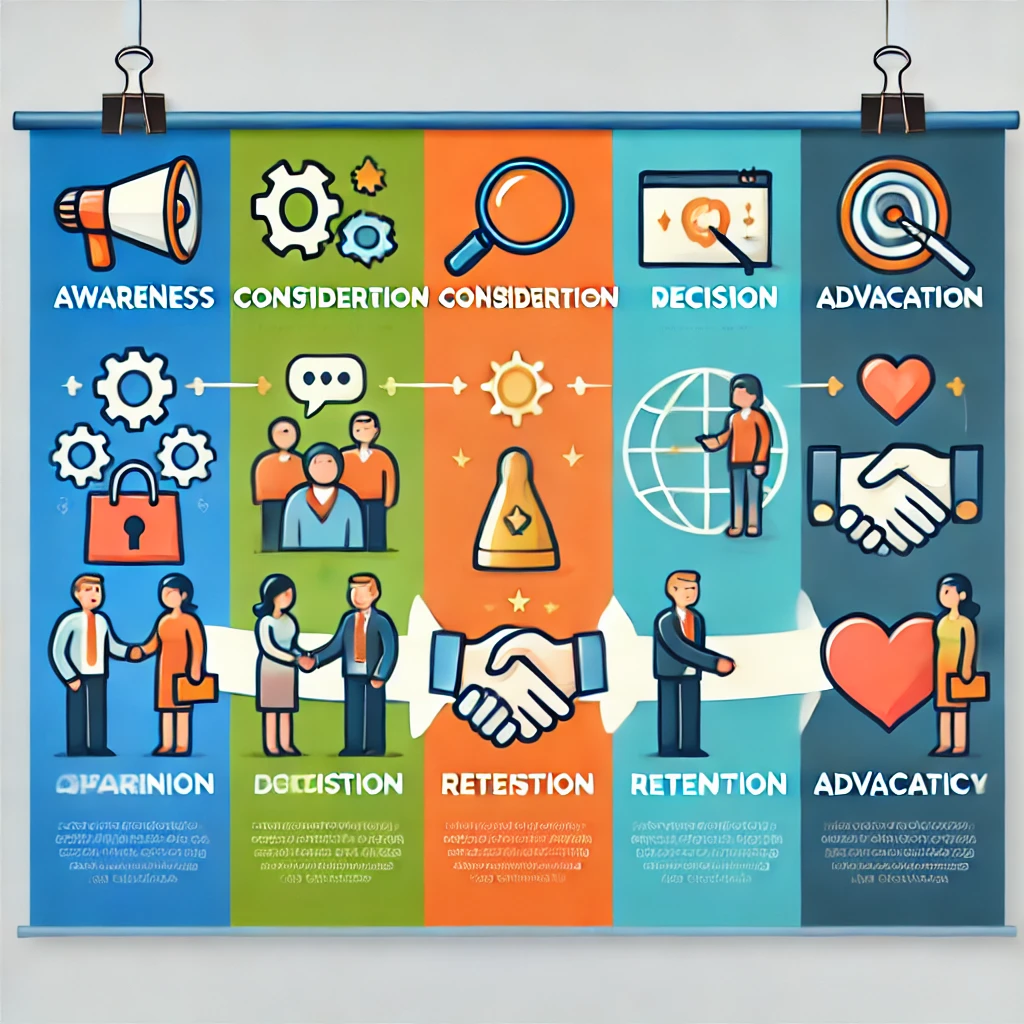In today’s fast-paced digital world, the customer journey has become more complex than ever. As businesses adapt to online environments, understanding how customers interact with brands across different touchpoints is essential for crafting effective marketing strategies. This process is known as the “customer journey,” and it refers to the path a customer takes from the moment they first discover a brand to the final purchase and beyond.
In this blog, we’ll dive into the importance of understanding the customer journey, the stages involved, and how digital marketing can be leveraged to guide customers from one step to the next.
What Is the Customer Journey?
The customer journey is the sequence of interactions a customer has with a brand from the awareness stage all the way through to post-purchase engagement. In digital marketing, this journey is often broken down into several key stages:
- Awareness
- Consideration
- Decision
- Retention
- Advocacy
Each of these stages presents unique opportunities and challenges, requiring different tactics to engage potential customers and guide them toward becoming loyal, repeat buyers.
Stages of the Customer Journey
1. Awareness Stage
The awareness stage is the first interaction between a potential customer and a brand. At this point, the consumer is facing a challenge or need but may not yet know about your product or service. Your goal here is to capture their attention through various channels like social media, search engines, blogs, or paid ads.
Digital Marketing Tactics:
- Content Marketing: Blog posts, videos, or infographics that provide value or solve problems.
- SEO (Search Engine Optimization): Ensure your website ranks for the keywords potential customers are searching for.
- Paid Advertising: Targeted ads on platforms like Google, Facebook, or Instagram to reach a broader audience.
2. Consideration Stage
Once the customer is aware of your brand, they enter the consideration stage. This is where they begin to evaluate your product or service against others. At this point, they are looking for more information to make an informed decision.
Digital Marketing Tactics:
- Email Marketing: Send personalized emails with helpful information, offers, or incentives.
- Retargeting Ads: Use display or social media ads to re-engage visitors who have previously interacted with your website.
- Webinars or Demos: Offer an in-depth look at your product or service to showcase its value.
3. Decision Stage
In the decision stage, the potential customer is ready to make a purchase. They’ve done their research, and now they need a final nudge to push them over the line. This is where your sales funnel gets more personalized, offering the right incentives to close the deal.
Digital Marketing Tactics:
- Product Reviews & Testimonials: Showcase customer reviews or case studies to build trust and validate your offering.
- Promotions or Discounts: Offering limited-time promotions can create a sense of urgency.
- Clear Calls to Action (CTA): Make the process of purchasing simple and straightforward with easy-to-find CTAs.
4. Retention Stage
The journey doesn’t end once a customer makes a purchase. The retention stage is just as crucial, as it focuses on keeping the customer satisfied and encouraging repeat purchases. Loyal customers are not only more likely to buy again but also to recommend your brand to others.
Digital Marketing Tactics:
- Customer Support & Engagement: Provide exceptional customer service, whether through live chat, email support, or social media.
- Loyalty Programs: Reward customers for their loyalty with discounts, early access to sales, or exclusive offers.
- Email Drip Campaigns: Stay top of mind by nurturing existing customers with valuable content, product recommendations, and updates.
5. Advocacy Stage
In the final stage, satisfied customers become advocates for your brand. These are the people who will leave positive reviews, share their experiences on social media, and recommend your product to friends and family.
Digital Marketing Tactics:
- Referral Programs: Encourage customers to refer others in exchange for rewards or discounts.
- User-Generated Content: Showcase customer photos, videos, or reviews as social proof.
- Engagement on Social Media: Foster a community by responding to customer comments and encouraging discussions.
Why Understanding the Customer Journey Matters
Understanding the customer journey allows businesses to meet customers where they are and provide the right information at the right time. When marketers align their digital strategies with the customer’s needs at each stage of the journey, they create a seamless experience that builds trust, drives conversions, and fosters loyalty.
Moreover, this insight helps in the efficient allocation of marketing resources. By understanding which channels and tactics work best at each stage, businesses can optimize their efforts to achieve better ROI.
Tips for Mapping the Customer Journey
1. Conduct Customer Research
To truly understand the customer journey, you need to listen to your customers. Use surveys, interviews, and analytics to gather insights into their needs, pain points, and preferences. This will help you create more targeted, effective marketing campaigns.
2. Create Buyer Personas
A buyer persona is a semi-fictional representation of your ideal customer. Creating these personas will help you understand the motivations and behaviors of different segments of your audience, which will allow you to craft content and campaigns that speak directly to their needs.
3. Use Analytics to Track Progress
By leveraging tools like Google Analytics, social media insights, and email marketing data, you can track how customers are moving through each stage of the journey. This data is invaluable for optimizing your strategies and improving customer experiences.
4. Deliver Consistent Experiences Across Channels
Customers now interact with brands across multiple platforms, from websites and mobile apps to social media and in-store. It’s important to provide a consistent brand experience across all these touchpoints. Ensure that your messaging, visuals, and tone remain aligned across every channel to build trust and credibility.
5. Personalize the Experience
Personalization is key to driving conversions and customer loyalty. Use data to personalize emails, offers, and advertisements based on customer behavior, past purchases, and browsing history.
Conclusion
The customer journey is a vital framework for understanding how consumers interact with your brand and what drives them to make purchasing decisions. By aligning your digital marketing efforts with each stage of the journey, you can effectively guide customers from initial awareness to loyal advocacy. Whether you’re focusing on SEO, content marketing, or social media engagement, understanding the customer journey is the key to creating a meaningful, long-lasting relationship with your audience.
As digital marketing continues to evolve, staying focused on the customer’s experience and adapting your strategies accordingly will keep your brand ahead of the competition.
At 7Shades Digital, we specialize in creating strategies that help businesses excel in the digital world. If you’re ready to take your brand to the next level, contact us today!





